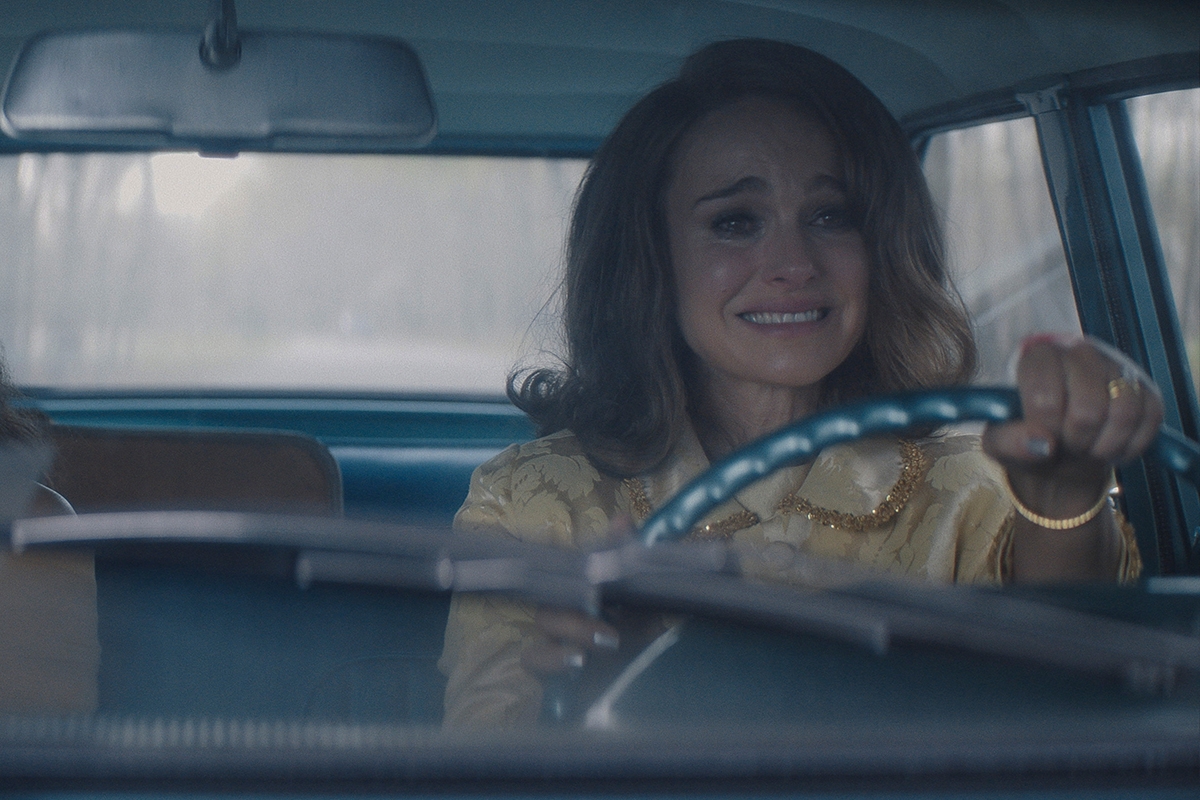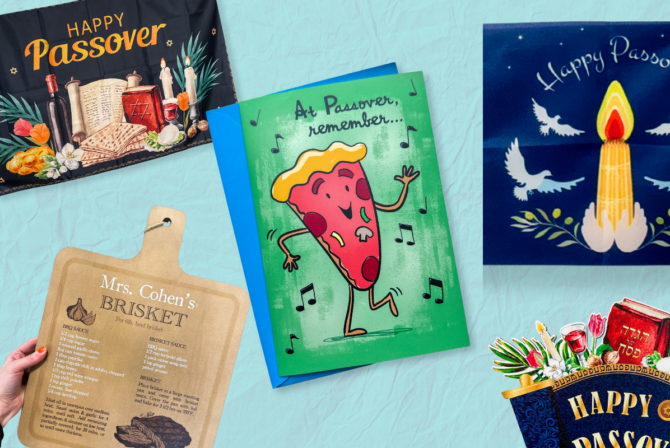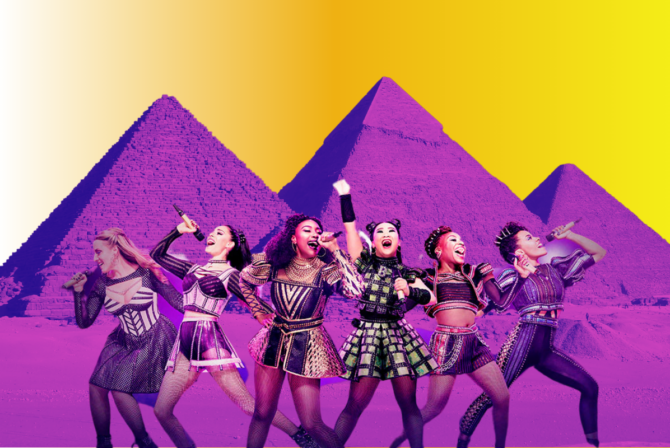We don’t get a lot of Jewish Thanksgiving episodes and well, why should we? Thanksgiving isn’t a Jewish holiday. When I first moved to the U.S. from Israel in my early 20s, a lot of Israelis asked me if it was even OK for Jews to celebrate Thanksgiving — most rabbis agree that it is, but the question persists.
This year, we got a Jewish Thanksgiving episode that paints so many complicated truths about being a Jewish person in America in expansive and rarely seen detail. And it stars none other than Natalie Portman.
“Lady in the Lake” is an incredible limited series directed by Israeli-American “Honey Boy” director Alma Har’el that aired on Apple TV+ this summer. The 1966 period thriller based on the novel by Laura Lippman tells the story of two women who lead parallel lives in very different parts of Baltimore. There’s Natalie Portman’s Maddie Schwartz, a Jewish housewife who leaves her husband and hopes to launch the journalism career she dreamed of as a teen, and there’s Cleo Johnson, played by a mesmerizing Moses Ingram (“The Queen’s Gambit”), a Black mother of two who works multiple jobs — as a bartender and bookkeeper at a nightclub, a living mannequin and a political volunteer — in hopes of building a better future for her family. Their lives become intimately connected following a dramatic disappearance.
The first episode of “Lady In the Lake” takes place on an eventful Thanksgiving Day and the first scene after the opening credits features not Cleo, nor Maddie, but 11-year-old Tessie Durst, a young Jewish girl from Pikesville (like Maddie). Tessie is with her family — her dad (David Cornsteet), her mother and her brother David — at Baltimore’s Thanksgiving Day Parade. We hear the narration of Wallace White (Charlie Hofheimer,) a local TV news anchor, as he talks about the floats, enthusiastically introducing Santa and his elves on a float helmed with giant turkey feathers. A man in an elf’s hat and a giant mailbox costume asks the young girl if she has a letter for Santa. And Tessie? She’s enraptured by it all and also deeply disappointed at her exclusion from all that magic as a Jew.
How does Santa know to skip their home? she asks her mother, who replies it’s the mezuzah at her door. She keeps up her line of questioning, wondering if she slept at a non-Jewish friend’s house, would he gift her something? That’s when Mrs. Durst breaks it to her: Santa isn’t real, and she can’t tell her friends, but her father, Alan, is going to buy her something for Hanukkah — a way less glamorous and pleasing idea. Tessie wants a seahorse, and as her parents are kvetching about parking around the parade, she wanders off by herself to a fish store.
The episode centers Tessie, who then goes missing. A repeated image becomes its center in the following scene, in which Maddie goes to a kosher butcher and gets herself a piece of 6-month old lamb — that of a lamb going to the slaughter. The meat stains her yellow outfit and brings about a flashback for Maddie to a harrowing moment from her teen years. The symbolism is clear: young Tessie is not the only one in the show who experiences losing her innocence. It’s an image we all know from the Genesis story of the Akedah, the binding of Isaac: that first biblical loss of childhood innocence. It’s another stunning way in which Har’el weaves echoes of Jewish observance and stories into this show full of dreamlike visual allusions.
Maddie has to change out of that blood stained outfit, quickly buying a new yellow one after seeing it on Cleo while she’s working as a living mannequin at a local department store. It’s their first meeting — their first time seeing each other. The saleswomen are shocked that she is willing to buy something worn by a Black woman, as the only remaining outfit is that Cleo is wearing, and then are shocked to find out that Maddie herself, who has such Jackie Kennedy glamour, is a Jew from Pikesville. It’s at the store that she first finds out about Tessie’s disappearance.
There is also such a sense of Jewish familiarity and community as Har’el paints this picture of the city’s 1960s Jewish community that feels so alive and full of little details, including the comforting familiarity between a Jewish housewife and her butcher. Maddie and her butcher chat in Yiddish-peppered English, the man calls her husband a mensch, she retorts that he’s a macher (a big shot).
“A macher knowns what money can’t buy, a beautiful wife running around to get him kosher lamb,” the butcher tells her. Har’el has built such a colorful world of the kosher butcher shop, filmed in Baltimore’s Hollins Market.
Maddie is late to a synagogue event because of her whirlwind wardrobe malfunction. The local pawnshop owner, Mr. Weinstein, comes to bother her and her family at their table. There’s her son Seth (Noah Jupe), her husband Milton (Brett Gelman) and her mother Tattie (Mindy Goldberg). Mr. Weinstein wants to talk business with Milton, about an apartment in the city’s Black neighborhood, the Bottoms, that he’s hoping to rent. “Do me a toyveh,” he said, the Yiddish word for favor. Mr. Schwartz responds: “It’s Thanksgiving, Mr. Weinstein!”
They then endeavor to answer that question many an Israeli asked me after I moved here: Do Jews celebrate Thanksgiving? Well, it might seem like that answer is a resounding yes, but still, to this day, it’s not so clear to some Jewish people. Mr. Weinstein, for example, is shocked. He incredulously asks the Schwartz family: “And you celebrate that?”
Maddie and Milton answer with resounding yeses, with Milton adding “we are Americans,” but Tattie Morgenstern — she refuses to celebrate it, too. The show offers a reminder of the fact that Thanksgiving is still considered by a select few, much fewer Jews than in the 1960s, a holiday for Gentiles, one that isn’t meant to be celebrated by Jews. And the question of Jewish assimilation is also at the heart of this show, in which Maddie navigates her otherness as a Jew as well as the way so many perceive her as white, and the opportunities that opens for her that are closed to Cleo and her family.
Yet the show also acknowledges antisemitism. Those subtle remarks from the women at the department store. A speaker at the synagogue talks about it in relation to the Nation of Islam. Wallie White, who we later find out is Jewish, was a schoolmate of Maddie and an impromptu invitee to the Schwartz’s Thanksgiving feast, talks about two men who started a local branch of the neo-Nazi State Rights Party: “If they start a movement in the middle of Baltimore, I pity any Jew who thinks they’re safe,” he says. White will later renounce the Dursts for being “too Jewish,” bringing in echoes of internalized antisemitism and the idea of “the good Jew” and “the bad Jew.” The complex, multiple layers of antisemitism and the story of Jewish assimilation are interwoven into this show in a way that feel very prescient, still freshly relevant in our modern Jewish American lives.
Then there’s the way the show portrays the Jewish community’s treatment of women. Maddie gets called to the stage at her synagogue as Mrs. Milton Schwartz, she thanks her husband for letting her stand there and speak, she talks about the morning blessings in which men say their thanks for not making them a gentile, a slave, a woman. “I’ve been told it’s because of the burdens that we women bear,” Maddie says to the crowd’s laughter. Later, when Maddie wants to join the synagogue’s search party for young Tessie, she is told that she can’t because she is a woman.
Nowadays, the world of Jewish American observance is full of women in positions of power — rabbis, cantors and activists, but in 1966, that was not the world of Jewish women. It is interesting to see the intersections and juxtapositions of what it meant to be a woman, Jewish and Black in the 1960s. And Har’el, who told Kveller that the show was her first time directing in Hebrew, also brings those of us who know that that “shelo ashani” (for not making me) prayer is still one said by many Jewish man to this day yet another layer of complexity to grapple with.
The Thanksgiving feast in this episode is not meant to be, sabotaged by Maddie’s confusion about dairy and meat dishes, another level of Jewish detail in this episode. But the whole show is full of details for American Jews to feast on, all put together in a gorgeously crafted, entrancing package created by a Jewish woman, starring an Academy Award winning Jewish actress in one of her most complex Jewish roles. The unprecedented layers of American Jewish specificities are something to be thankful for, and it is certainly a worthy Thanksgiving binge, especially for those of us who relish a complicated, meaty show.








